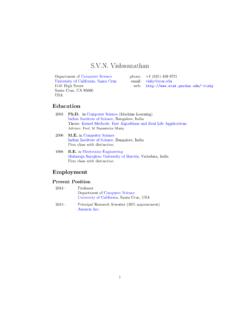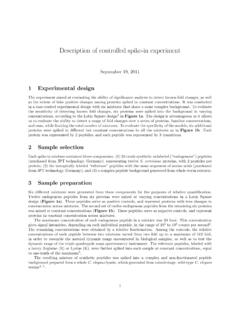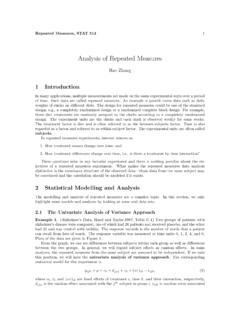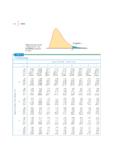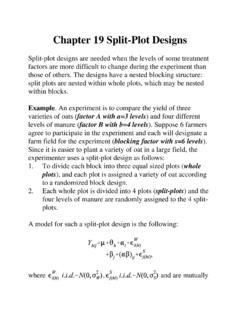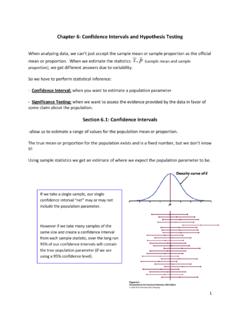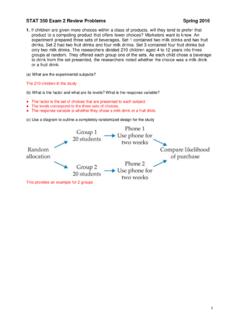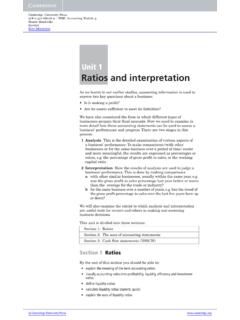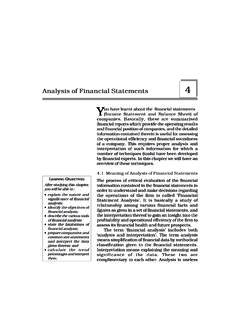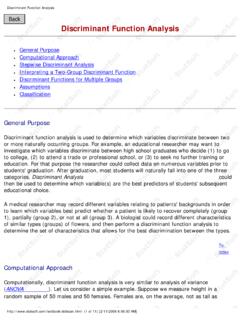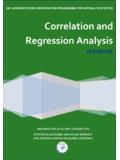Transcription of Technical Analysis Approach: part I - Purdue University
1 Understanding the market Technical Analysis Approach: part I Xiaoguang Wang President, Purdue Quantitative Finance Club PhD Candidate, Department of Statistics Purdue University Outline Why Technical Analysis ? Philosophy of Technical Analysis Fundamental assumptions Definitions of trend, support and resistance Different Charting styles Reversal and Continuation patterns Principle of Confirmation and Divergence MetaTrader4 introduction Conclusion Question: How to trade successfully in the market? Profits significantly out-beat risk-free rate or the return of market index Statistically stable performance in a long run The worst loss is still affordable Trading formula Expected profits = (Target price entry price)*P{success} (Entry price stop price)*P{failure} Decision making: Determine (Entry price, Target price, Stop Price) such that the expected profits can be maximized. The role of Technical Analysis Help you make the selection among the three choices at any fixed time t: 1.
2 Open a position 2. Close a position 3. Do nothing The history of Technical Analysis Dow Theory: Charles H. Dow published the first stock market average on July 3, 1884. The ABC of Stock Speculation, Nelson, 1903. (The first book the term Dow Theory was used.) Dow Theory, Robert Rhea, 1932. Elliott Wave Theory: The wave principle was published in 1938 by Charles J. Collins, which was based on the original work of Ralph Nelson Elliott. William D. Gann: Geometric angels and percentages. Most work was published during the 1950s and 60s. For more information: Philosophy of Technical Analysis Market action discounts everything. Prices move in trends : A trend in motion is more likely to continue than to reverse. (An adaptation of Newton s first law of motion.) History repeats itself. Basic foundations behind Technical Analysis Price discounts everything Price movements are not totally random The market has Three trends (Dow) Major trends have three phase (Dow) Volume must confirm the trend A trend is assumed to be in effect until it gives definite signals that it has reversed The market is more psychological than logical Doubts and Criticisms The doubts and criticisms have a history as long as that of the theory: Can the past be used to predict the future?
3 Signals are always too late? Analyst Bias: subjective interpretation; art vs. science Trader s Remorse: Not all signals and patterns work Always another level: Bullish or Bearish? Description vs. Prediction What is more important than why ! Technical Analysis at least is an effective description of the market prices. It helps us know what the market is saying at the moment. It is a popular language used by traders to describe the market. Definitions Trend: An upper trend is a series of successively higher peaks and troughs; a downtrend is just the opposite, while horizontal peaks and troughs would identify a sideways price trend (trendless). Remark: It is the direction of those peaks and troughs that constitutes market trend. Example of trends Support and resistance Support is a level or area on the chart under the market where buying interest is sufficiently strong to overcome selling pressure and a decline is halted and prices turn back up.
4 Resistance is a level or area over the market where selling pressure overcomes buying pressure and a price advance is turned back. Tested support and resistance are more reliable. Previous peaks and troughs are potential supports and resistances. Some other candidates can be those levels or areas indicated by indicators such as MA, trend channels, percentages and so on. Examples of supports and resistances More examples Remarks on supports and resistance Finding supports and resistance plays the key role of Technical Analysis . This is the hardest part in developing a trading strategy based on Technical Analysis . All the indicators and tools are to help you in two perspectives: 1. evaluate the strength of potential supports and resistances. 2. evaluate the spot probability of price going up vs. going down at the moment. Good trading opportunities are those levels that satisfy the 3:1 rule and have a high odds ratio.
5 Charting Ways to describe or plot the market prices. Different types of charts: Bar Chart Candle-stick Chart Point and Figure (OX chart) Market profile Pro-Sticks chart Goal: keep the basic trend or shape of historical prices while omit most prices that not important in Technical Analysis perspective. Good references Candlestick: OX Chart: :chart_analysis:pnf_charts Market Profile ProStick Bar Chart and Candlestick Chart Candle types Summary for Candle types Long white candlesticks indicate that the Bulls controlled the ball (trading) for most of the game. Long black candlesticks indicate that the Bears controlled the ball (trading) for most of the game. Small candlesticks indicate that neither team could move the ball and prices finished about where they started. A long lower shadow indicates that the Bears controlled the ball for part of the game, but lost control by the end and the Bulls made an impressive comeback.
6 A long upper shadow indicates that the Bulls controlled the ball for part of the game, but lost control by the end and the Bears made an impressive comeback. A long upper and lower shadow indicates that the both the Bears and the Bulls had their moments during the game, but neither could put the other away, resulting in a standoff. Drawbacks of Candle Chart Omit all the information except for HLOC within a time interval (one candle), some of which, however, might be important, especially the statistical information of the price magnitude change (Market Profile), assigned volume information such as the prices that most volume concentrate on (Pro-Stick). Chart can be further contracted, especially when price moves in a very narrow range for a long time (OX Chart). OX Chart Focus on the magnitude changes of prices rather than the changes of prices on time domain. More on OX Chart You can apply similar patterns used in candlesticks chart to the OX chart OX chart used for target price predictions Bull trap and Bear trap Bullish Catapult Summary for OX Chart Filter insignificant price movements and noise Focus on important price movements Remove the time aspect from the Analysis process Make support/resistance levels much easier to identify Provide automatic and subjective trendlines Market Profile A chart that displays market data using Time Price Opportunities (TPOs).
7 A TPO is a price that the market traded at during a specific period. The typical market profile chart splits the trading day into thirty minute segments or periods. The market data for each period is displayed on the basis of a normal distribution. Foundations behind One can combine the candle chart together with the Market Profile Combination Summary on Market Profile Focus on the time-based distributional information of price changes within a time interval More detailed version of Candle chart Still not directly reflect much on the assigned volume information of the price changes Pro-Stick The introduction of ProSticks attempts to reduce the limitations of Market Profile and other Technical Analysis and charting tools while, at the same time, integrates the elements of volume and time into traditional Technical Analysis and charting. ProSticks has two variations: ProSticks-By-Time and ProSticks-By-Volume ProStick-by-Time & ProStick-by-Volume The Modal Point in a ProStick bar represents the most heavily transacted price for the particular time interval.
8 ProSticks-By-Time calculates the Modal Point similar to the way Market Profile builds its bell-curve distribution. The Modal Point is then simply the price with the most number of transacted 5-minute intervals for all transacted prices in the trading interval ProSticks-By-Volume calculates the Modal Point simply by taking the most heavily traded price for the trading day (or other trading intervals). The Modal Point is thus the price that had the most shares traded for that particular day. The Active Range for both ProSticks-By-Time and ProSticks-By-Volume is computed by first calculating the mean of the entire distribution. Then the first standard deviation away from the mean in either direction is added together to form the Active Range. The Active Range equals approximately 68 percent of the entire distribution ProStick vs. Candlestick Summary for ProStick Combine the advantages of both Candlestick and Market Profile Help to more accurately find support and resistant points Can be used to confirm or deny signals indicated by candlestick theories It is more reasonable to take Modal Point as reference compared to close price or H/L price when do Technical Analysis .
9 Price Patterns Classification and description of sideways market movements Market price curve = trend_1 + pattern_1 + trend_2 + pattern_2 +..+ trend_i + pattern_i +.. Reversal Patterns & Continuation Patterns Volume often plays an important role in determining the reliability of patterns Most price patterns also have certain measuring techniques that help determine the minimum price objectives. Reversal Patterns A prerequisite for any reversal pattern is the existence of a prior trend The first signal of an impending trend reversal is often the breaking of an important trendlines The larger the pattern, the greater the subsequent move Topping patterns are usually shorter in duration and more volatile than bottoms Bottoms usually have smaller price ranges and take longer to build Volume is usually more important on the upside Major reversal patterns The Head and Shoulder (H&S) Triple tops and bottoms Double tops and bottoms Spike (V) tops and bottoms Rounding pattern Head and Shoulder Prices should not move across the Neckline again, otherwise it would be treated as a failed head and shoulder Volume matters!
10 Non-standard head and shoulder Triple Tops and Bottoms A slight variation of head and shoulder The volume tends to decline with each successive peak at the top and should increase at the breakdown point. Double Tops and Bottoms The pattern has two peaks (A and C) at about the same level. The pattern is complete when the middle trough at point B is broken on a closing basis. Volume is usually lighter on the second peak C and picks up on the breakdown D. A return move back to the lower line is not unusual. The minimum measuring target is the height of the top projected downward from the breakdown point. Extensions: Divergence Sometimes the second or third peak can be significantly higher than the previous peak, thus a double or triple top pattern fails. But this still can be treated as a reversal pattern as there is obvious evidence of divergence between the price curve and some indicator such as MACD. Abuse of Double tops and bottoms Remark: The neckline must be crossed before confirming a reversal double tops or bottoms The price levels should be high or low enough to be considered as reversal patterns Rounding tops or bottoms Spike (V) Tops and Bottoms Continuation patterns These patterns usually indicate that the sideways price action on the chart in nothing more than a pause in the prevailing trend and the next move will be in the same direction as the trend that preceded the formation.
